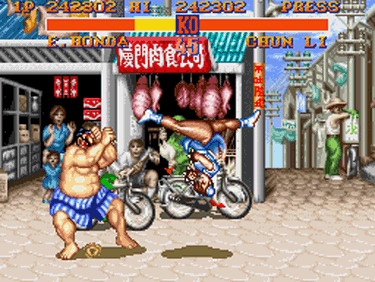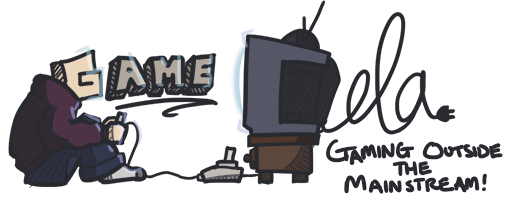HADOKEN! That one word holds a special place in any fighting game fan’s heart. Hell, I have the button sequence formed into my thumbs from playing Street Fighter II entirely too much! Seriously, though, Street Fighter II on the SNES gave me a large callous in the middle of my left thumb that I still have to this day.
When I think of SFII, I think of fighting game perfection. I think of the many games it paved the way for. I think of the mark it left in the videogame industry. What I also think of are the four other versions of this game that were released, and how Capcom managed to perfect the already perfect fighting juggernaut. What I’m trying to mumble out is that SFII is utterly AMAZING!
Created in 1991 and eventually released for the SNES in 1992 by Capcom, SFII focuses primarily on two fighters from the original Street Fighter: Ken and Ryu. Oddly enough, the intro to SFII features two other characters, with one punching the other in the face. These characters were none other than Joe and Mike, the two US fighters from the original SF. Neither would actually return this time around, although there are unconfirmed speculations about Mike and Balrog being the same person.
With an expanded Versus Mode, SFII allows players to select one of eight playable characters to fight it out in one of the most well-balanced fighters in history, either in the arcade/story mode or a Versus match against a human opponent. The “original eight” are Blanka, Ken, Ryu, Guile, Dhalsim, Zangief, Chun-Li and E. Honda; but sadly, due to limitations, same-character matches were unavailable until SFII Champion Edition launched later in 1992.
After defeating each character in the arcade mode, you’re forced to fight the three sub-bosses (Vega, Balrog, and Sagat) before getting bitched like a n00b by M. Bison. If you’re good enough to defeat him, you’re greeted by a character-specific ending, hopefully entering your initials into the high-score screen.
Just to clear something up as well, the names of three of the four boss characters were changed in the North American versions of SFII due to legal controversy surrounding the use of the name Mike Bison. Capcom used the name to compare the boxing character to American boxing legend (stay with me here) Mike Tyson, but the name was eventually switched to Balrog, which was Vega’s name. Vega was originally the name of M. Bison and Balrog was the original name for Vega. Sagat was lucky and got to keep his name. Hopefully that wasn’t TOO confusing.
SFII defined the term “skill” when it comes to fighting games. It also introduced something that many modern fighters lack. That something is called “balance”, where no other character could dominate a certain person if given the proper amount of education and practice.

One of the mainstays in the SF universe is the use of “special moves”, which each character can utilize by rotating or “charging” the directional pad, followed by the press of an attack button. These are all character-specific, outside of Ken and Ryu’s. Characters were also separated into two types: offensive and defensive. Offensive characters usually have special attacks that consist of rotating the control pad either a quarter or half-circle forwards/backwards followed by an attack button. Defensive characters are usually the “charge” characters, where one has to charge away or down for two seconds before pressing the opposite direction and an attack button simultaneously. This usually helps these character stay on the defensive end, since holding the joystick away from the opponent causes you to block their attacks.
This, however, created something that we hardcore SF fans loathe and refer to as “turtling”, where players crouch and block at the same time to avoid any attack outside of being thrown, and then capitalizing on opponents’ mistakes. This feature was later fixed in Super Street Fighter II: Turbo in 1994 by the addition of “overhead” attacks. More on that in a future review, though.
The graphics of the arcade version of SFII were great for their time, but, along with the overall framerate of the game, they were reduced for the home conversions. A great example of framerates being cut is the animation of Ken and Ryu’s jumping forward kick, where it simply goes from the standard straight jumping animation to a frozen frame of an arcade kicking animation. North American gamers weren’t struck as hard as the European gamers, though, when the game was dissected down from 60 Hz to 50 Hz, making it approximately 17% slower than the North American release.
Either way, if you owned a SNES and actually were cool enough to have friends that admitted to playing videogames, this was the game to own. Enough hours of practicing or losing on the hardest difficulty could make you a solid player, but learning the tricks of the trade and when to use which attacks made you elite.

The soundtrack in SFII is good, but generic at the same time. It’s a dated game, so I’m not holding this against it at all. It’s more than the Atari’s bloops and bleeps, but it’s just…there. The sound effects are great while punching and kicking your opponent into the corner before rearranging their entire upper-body with a Spinning Piledriver as well. Not to mention the destructible environment noises! The breaking of Bison’s statues, Guile’s boxes, or Ken’s oil cans add to game’s flare.
Overall, this is where the Street Fighter franchise grew from, and it’s amazing to play all five versions of the game to see how it was perfected. The sheer amount of balance and skill in this game is amazing for it’s time, and it still stands strong among the new-comers. A big thing worth noting is that this was one of the first fighting games to use destructible environments. It adds insult to injury to throw Guile into his own boxes, or to rock Ken’s jaw to send him through his own oil cans.
It isn’t all about flashy graphics and 100-hit combo throws by sweaty buff men in tiger masks, either. Zangief (or as I call him, “The Gief”) would own King any day of the week. His sculpted chest hair and red Speedo are unstoppable! SFII requires a lot of skill to be able to stand your own ground among the SF elite. Picking up the controller and mashing buttons make you look like a complete tool while your skilled friend ( i.e., me) brings the pain from all directions with Sonic Booms, Yoga Flames, Hundred Hand Slaps, and Hurricane Kicks.
So grab your books, n00b…it’s time to get schooled!

